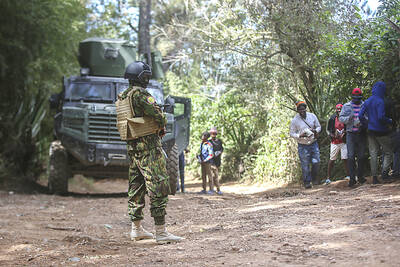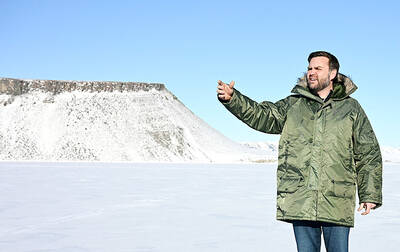Australian Prime Minister Kevin Rudd left Canberra for his first visit to Japan as leader yesterday, playing down criticism that he had taken too long to travel to the major Asian power.
Rudd, who was elected to office in late November, flew out of the national capital shortly after 9am for the visit, a spokeswoman said.
Opposition politicians have accused the prime minister of snubbing Tokyo in favor of Beijing by skipping Japan during his first lengthy foreign trip which saw him visit the US, Europe and China in March and April.
Ahead of his flight, Rudd said the relationship with Japan was in “first-class working order.”
But the avowed Sinophile, who spent years living in Beijing as a diplomat and who speaks fluent Mandarin, said that good relations were needed with all Asian partners.
“Japan is a partnership which is anchored in our comprehensive engagement on strategic matters, security matters and economic matters,” he said. “It goes back a long time.”
“Also, we’ve got other partners within the region as well. China and Japan between them are our largest trading partners. They are huge and so it’s important to attend to all of these relationships,” he said.
Rudd said he wanted to take Canberra’s partnership with Japan “to the next stage” and would discuss increasing security cooperation with Japanese Prime Minister Yasuo Fukuda.
The issue of Japanese whaling in the Southern Ocean — which Australia strongly opposes — will feature among talks, but Rudd said Canberra would seek to resolve the matter diplomatically rather than through international courts.
“We have clear principles when it comes to the proper protection of whales in the Southern Ocean. Japan has a different view,” Rudd said. “We’ll seek to resolve that diplomatically and let’s see how the diplomacy runs. But this is a disagreement among friends.”
Accelerating negotiations for a free-trade agreement are also expected to be on the table during Rudd’s meeting with Fukuda.
Also See: Australian team to join UN assistance mission in Darfur

DITCH TACTICS: Kenyan officers were on their way to rescue Haitian police stuck in a ditch suspected to have been deliberately dug by Haitian gang members A Kenyan policeman deployed in Haiti has gone missing after violent gangs attacked a group of officers on a rescue mission, a UN-backed multinational security mission said in a statement yesterday. The Kenyan officers on Tuesday were on their way to rescue Haitian police stuck in a ditch “suspected to have been deliberately dug by gangs,” the statement said, adding that “specialized teams have been deployed” to search for the missing officer. Local media outlets in Haiti reported that the officer had been killed and videos of a lifeless man clothed in Kenyan uniform were shared on social media. Gang violence has left

US Vice President J.D. Vance on Friday accused Denmark of not having done enough to protect Greenland, when he visited the strategically placed and resource-rich Danish territory coveted by US President Donald Trump. Vance made his comment during a trip to the Pituffik Space Base in northwestern Greenland, a visit viewed by Copenhagen and Nuuk as a provocation. “Our message to Denmark is very simple: You have not done a good job by the people of Greenland,” Vance told a news conference. “You have under-invested in the people of Greenland, and you have under-invested in the security architecture of this

Japan unveiled a plan on Thursday to evacuate around 120,000 residents and tourists from its southern islets near Taiwan within six days in the event of an “emergency”. The plan was put together as “the security situation surrounding our nation grows severe” and with an “emergency” in mind, the government’s crisis management office said. Exactly what that emergency might be was left unspecified in the plan but it envisages the evacuation of around 120,000 people in five Japanese islets close to Taiwan. China claims Taiwan as part of its territory and has stepped up military pressure in recent years, including

UNREST: The authorities in Turkey arrested 13 Turkish journalists in five days, deported a BBC correspondent and on Thursday arrested a reporter from Sweden Waving flags and chanting slogans, many hundreds of thousands of anti-government demonstrators on Saturday rallied in Istanbul, Turkey, in defence of democracy after the arrest of Istanbul Mayor Ekrem Imamoglu which sparked Turkey’s worst street unrest in more than a decade. Under a cloudless blue sky, vast crowds gathered in Maltepe on the Asian side of Turkey’s biggest city on the eve of the Eid al-Fitr celebration which started yesterday, marking the end of Ramadan. Ozgur Ozel, chairman of the main opposition Republican People’s Party (CHP), which organized the rally, said there were 2.2 million people in the crowd, but